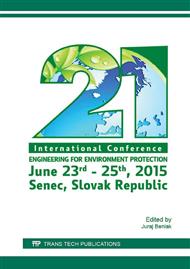[1]
A.L. Mourad, E.E.C. Garcia, G.B. Vilela, Influence of recycling rate increase of aseptic carton for long-life milk on GWP reduction, Resources, Conservation and Recycling 52 (2008) 678–689.
DOI: 10.1016/j.resconrec.2007.09.001
Google Scholar
[2]
A. Visconti, M. Miccio, D. Juchelková, An aspen plus® tool for simulation of lignocellulosic biomass pyrolysis via equilibrium and ranking of the main process variables, International Journal of Mathematical Models and Methods in Applied Sciences 9 (2015).
Google Scholar
[3]
J. Hayday, D. Susa, J. Dudas, Pyrolysis aseptic packages (tetrapak) in a laboratory screw type reactor and secondary thermal/catalytic tar decomposition, Waste Management 33 (2013) 1136-1141.
DOI: 10.1016/j.wasman.2013.01.031
Google Scholar
[4]
Korkmaz, J. Yanik, M. Brebu, C. Vasile, Pyrolysis of the tetra pak, Waste Management 29 (2009) 2836-2841.
DOI: 10.1016/j.wasman.2009.07.008
Google Scholar
[5]
X. Wei, G. Zhang, Y. Cai, L. Li, H. Li, The volatilization of TE during oxidative pyrolysis of a coal from an endemic arsenosis area in southwest Guizhou, China, J. Anal. Appl. Pyrolysis 98 (2012) 184–193.
DOI: 10.1016/j.jaap.2012.08.015
Google Scholar
[6]
R. Meij, Trace element behavior in coal-fired power plant, Fuel Processing Technology 39 (1994) 199–271.
DOI: 10.1016/0378-3820(94)90180-5
Google Scholar
[7]
H., Raclavská, A. Corsaro, D. Juchelková, V. Sassmanová, J. Frantík, Effect of temperature on the enrichment and volatility of 18 elements during pyrolysis of biomass, coal, and tires, Fuel Processing Technology 131 (2015) 330-337.
DOI: 10.1016/j.fuproc.2014.12.001
Google Scholar
[8]
J.E. Rodríguez-Goméz, S. Silva Reynoso, Y.Q. Varela-Querrero, V.A. Barrera-Diaz, Development of a process using waste vegetable oil for separation of aluminum and polyethylene from Tetra Pak, Fuel 149 (2015) 90-94.
DOI: 10.1016/j.fuel.2014.09.032
Google Scholar
[9]
D. Yan, Z. Peng, Y. Liu, L. Li, Q. Huang, M. Xie, Qi. Wang, Optimizing and developing a continuous separation system for the wet process separation of aluminum and polyethylene in aseptic composite packaging waste, Waste Management 35 (2015).
DOI: 10.1016/j.wasman.2014.10.008
Google Scholar


